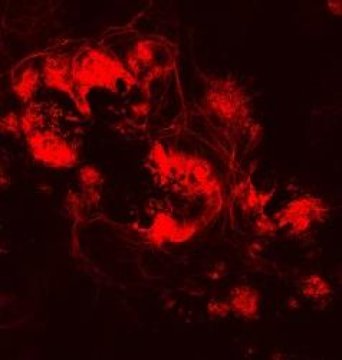American biologists have managed to turn stem cells into retinal nerve cells

Fluorescence microscopy results
Researchers at the Johns Hopkins University School of Medicine (USA) have developed a method to turn stem cells into retinal nerve cells. It is these cells that transmit visual signals from the eye to the brain. The discovery will help in the fight against retinal diseases such as glaucoma and multiple sclerosis.
To achieve this impressive result, the researchers edited the stem cell genome and added the fluorescent protein gene to it. For editing, the well-known CRISPR-Cas9 technique was used . According to the experimental plan, the fluorescent protein was to be secreted only together with another, BRN3B - and it is secreted by the mature retinal nerve cells.
Then, using fluorescently activated cell sorting, they isolated the formed ganglion (retinal nerve cells) cells in a separate population in order to study the resulting material.
According to research leader Donald Zack, the biological and physiological properties of the resulting cells coincided with the natural cells of the retina. It was also noted that the addition of forskolin on the first day of cell development significantly increased the efficiency of the process of converting stem cells into ganglion cells.
Forskolin is a substance produced by the Coleus forskohlii plant. Currently, it is actively used in research related to stem cells. Forskolin boosts levelscyclic adenosine monophosphate , which plays the role of a secondary messenger in the body, used to propagate signals in cells.
In addition, forskolin is often used to reduce weight and gain muscle mass. However, the researchers are in a hurry to warn that no clinical trials in connection with its use for the treatment of eye diseases have been conducted.
“Our work can not only increase our knowledge about the operation of the optical nerve, but also improve the cellular model of the human body, which, in turn, will help develop drugs that treat or stop the development of eye diseases,” Zack explains.
